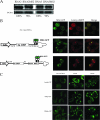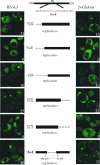Interactions between brome mosaic virus RNAs and cytoplasmic processing bodies
- PMID: 17609284
- PMCID: PMC2045432
- DOI: 10.1128/JVI.00844-07
Interactions between brome mosaic virus RNAs and cytoplasmic processing bodies
Abstract
Cytoplasmic processing bodies are sites where nontranslating mRNAs accumulate for different fates, including decapping and degradation, storage, or returning to translation. Previous work has also shown that the Lsm1-7p complex, Dhh1p, and Pat1p, which are all components of P bodies, are required for translation and subsequent recruitment to replication of the plant virus brome mosaic virus (BMV) genomic RNAs when replication is reproduced in yeast cells. To better understand the role of P bodies in BMV replication, we examined the subcellular locations of BMV RNAs in yeast cells. We observed that BMV genomic RNA2 and RNA3 accumulated in P bodies in a manner dependent on cis-acting RNA replication signals, which also directed nonviral RNAs to P bodies. Furthermore, the viral RNA-dependent RNA polymerase coimmunoprecipitates and shows partial colocalization with the P-body component Lsm1p. These observations suggest that the accumulation of BMV RNAs in P bodies may be an important step in RNA replication complex assembly for BMV, and possibly for other positive-strand RNA viruses.
Figures





References
-
- Barbee, S. A., P. S. Estes, A. M. Cziko, J. Hillebrand, R. A. Luedeman, J. M. Coller, N. Johnson, I. C. Howlett, C. Geng, R. Ueda, A. H. Brand, S. F. Newbury, J. E. Wilhelm, R. B. Levine, A. Nakamura, R. Parker, and M. Ramaswami. 2006. Staufen- and FMRP-containing neuronal RNPs are structurally and functionally related to somatic P bodies. Neuron 52:997-1009. - PMC - PubMed
Publication types
MeSH terms
Substances
Grants and funding
LinkOut - more resources
Full Text Sources

